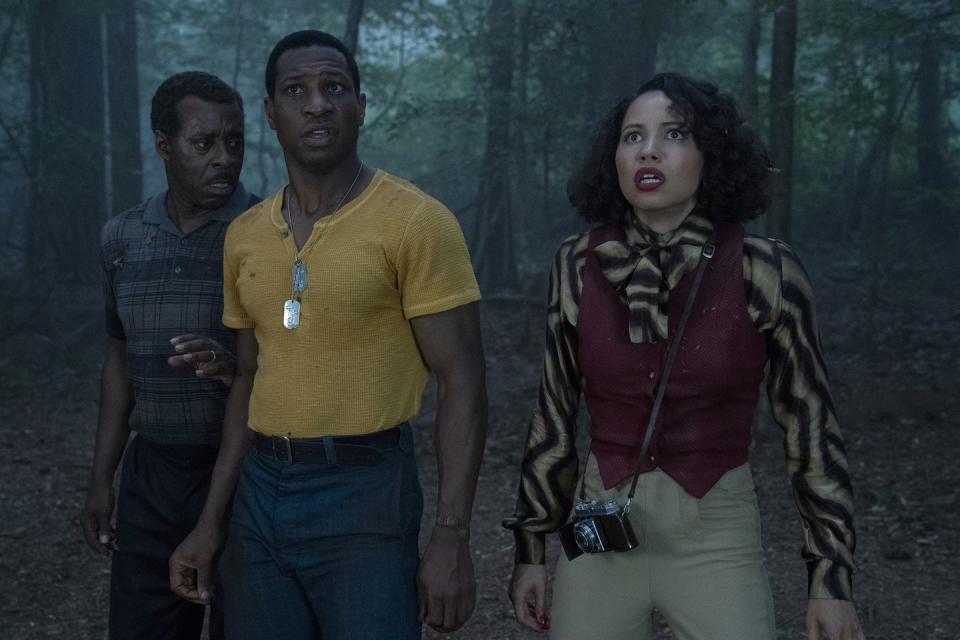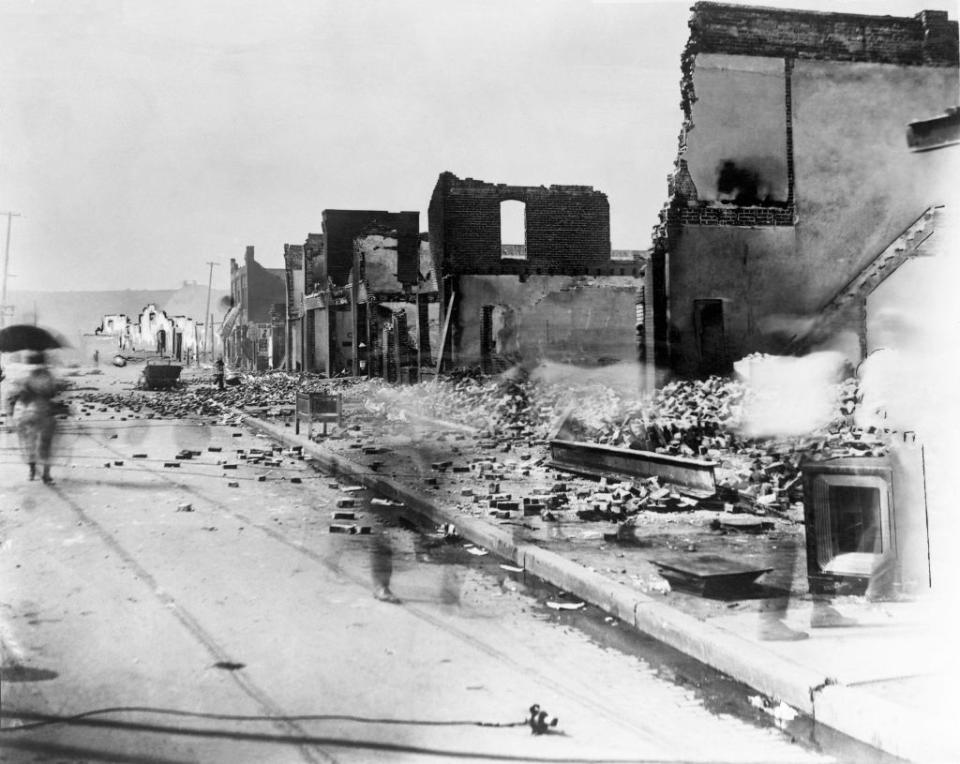The Cast of "Lovecraft Country" On the Scariest Part of a Terrifying Show

Lovecraft Country is a 10-episode HBO series based on the book of the same title by Matt Ruff.
Starring Jonathan Majors and Jurnee Smolett, the show uses elements of fantasy and horror to explore the prevalence and experience of racism in the U.S.
Lovecraft Country draws from real history, like the Green Book travel guide and Sundown Towns.
Lovecraft Country, a new show that premieres on HBO on August 16, is teeming with too many gasp-worthy, terrifying moments to count. Watch out, especially, for the monsters in the first episode, designed to slither into your nightmares.
But the show's fantastical elements aren't its scariest aspect. No, the most chilling parts of Lovecraft Country are the parts that are completely real. Over the course of 10 episodes, Lovecraft Country uses the horror genre tropes, like haunted houses and ghosts, to explore America's racist past—and present.
"To me, the scary parts were the parts that deal with racism in America. Not the monsters. Lovecraft serves as a timeline of a series of events that led us to where we are today. To have Lovecraft as a mirror, at this time, is very poignant," Michael Kenneth Williams, best known for playing Omar in The Wire, tells OprahMag.com during a press junket.

Based on Matt Ruff's novel of the same name, Lovecraft Country follows a series of Black Chicago natives during encounters with the supernatural in the year 1955. The show's title is derived from horror writer H.P. Lovecraft, whose monstrous creations—which continue to influence pop culture—have often overshadowed the idea that he, himself, was racist.
Structured like a series of interlinked short stories, each episode features the same characters on a standalone adventure that subverts Lovecraft's work. Here are a few of the real historical phenomena that provided the basis for some of Lovecraft Country's most terrifying moments.
The premiere episode is set in a Sundown Town.
The first episode, out Sunday, August 16, adds additional horror to a premise that was already inherently perilous: Driving while Black through Jim Crow America. In order to find his missing father, Korean war vet Atticus (Jonathan Majors) sets off on a road trip with his friend, Leticia "Leti" Lewis (Jurnee Smolett), and his uncle, George Freeman (Courtney B. Vance).
The first danger that the traveling trio encounter is, unfortunately, all too human. After barely escaping a town hostile to Black travelers, a predatory sheriff informs Atticus he's in a "Sundown Town," an all-white community in which Black people were at risk after dark—and the sun is setting.

The fact that 14-year-old Emmett Till was lynched in 1955, the same year that Lovecraft Country is set, looms over this encounter. Similar to Lovecraft Country's characters, Till was a Chicago native traveling in a white-dominated part of the U.S. Should the sheriff pull them over, Atticus and his loved ones could face the same tragic fate as Till.
So begins one of the most excruciating chase scenes. Atticus is trapped in a thankless paradox: He must cross county lines before the sun sets to avoid retribution, but can't exceed the speed limit and risk being pulled over. The law, according to this scene, is nothing more than a set of rules designed to entrap people, not protect them; and law enforcement nothing more than the gleeful enablers of an unjust system.
"Gripping that steering wheel? That's real sweat in the car. The amount of tension that was pulsing through us. A lot of that scene was improv. We were just barking at each other," Majors says of the tense scene.
One of the characters is a publisher of a guide for Black motorists, similar to The Green Book.
Published between 1936 and 1966, The Green Book was a travel guide that listed towns and businesses friendly to Black travelers, and helped people navigate the dangerous terrain depicted in Lovecraft Country. The motto ominously pointed to potential danger: "Carry your Green Book with you—you might need it." The Green Book's publication coincided with the Great Migration, a period in which six million Black Americans traveled from the South to the North.
"The businesses listed in it were critical sources of refuge along lonely stretches of America’s perilously empty roads. To stay safe, Black folks never left home without a plan, props, a cover story, and a copy of the Green Book. It was a powerful tool used by Black Americans to persevere and literally move forward in the face of racism," Candacy Taylor wrote in her 2020 book, The Overground Railroad.
In Lovecraft Country, George is the editor of a guide modeled off of Victor Hugo Green's Green Book. He travels with Atticus to review various businesses. "I don't think it's a coincidence that his name is Freeman. These folks were self-liberating, and trying to do so for themselves and their community for their travel," Aunjanue Ellis, who plays Hippolyta, says.
The legacy of the Green Book was also explored in the 2018 movie Green Book. Though the movie won the Academy Award for Best Picture, Green Book drew criticism for centering the travel experience on a white driver, not on his passenger, a Black musician on tour in the South.
Works like Lovecraft Country challenge us to imagine history through a more empathetic perspective; not as a page on a textbook, but as experiences people lived through. "What's painful is that we look at it, and we say, 'Yeah, that's just the way it is. Folks had to put a book together in order to drive down South.' Just looking at the inhumanity of that—no other people had to put a book together to travel. It harms all of us," Vance says.
Like Watchmen, characters deal with the fallout of the Tulsa Race Massacre in 1921.
Like the HBO show Watchmen, Lovecraft Country also explores the 1921 Tulsa Race Massacre through the lens of sci-fi and fantasy. Considered the worst incident of racial violence in America, the Tulsa Race Massacre resulted in the deaths of at least 300 Black Tulsa residents and the destruction of a thriving, self-contained economy known as Black Wall Street. "Tulsa was an affluent, educated, forward moving community. They were squelched. They were massacred," Majors says.
On May 31, 1921, hundreds of white residents descended on the Greenwood district, setting fire and dropping kerosene bombs on Black-owned businesses and residences. "It was a response to Black people accumulating wealth. Having their own businesses. Having self-sustained communities. The reaction from the white community around them in Tulsa was to murder them," Ellis says.

Lovecraft Country reflects dynamics still present in modern-day America, too.
Lovecraft Country premieres in a summer of change. The May murder of George Floyd, a Black man, at the hands of a white police officer, sparked protests around the country, demanding an end to systemic injustice and police brutality.
The cast sees a direct line between the period piece and life in modern-day America. "There's a line in the show where we say, 'The past is a living thing.' A living thing, not a lived thing. We walk around with the past daily," Majors says.
Wunmi Mosaku, who plays Ruby Baptiste, puts it another way. "The scariest part of the show is the truth of the show. As much as it's set in the past, it still feels very relevant and prominent. It resonates within me," she says. "There's a true understanding of the fears and horrors that these people experience."
For more stories like this, sign up for our newsletter.
You Might Also Like

